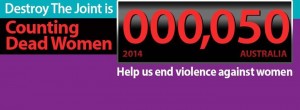Too many women, too many children – killed by husbands and fathers.

From the Domestic Violence Death Review Action Group
And it is done in the context of domestic violence.
These murders are about power and control, a sense of male entitlement and for revenge.
And yet we continue to hear about the suffering of these fathers and husbands – their grief over separation from their wives and children.
Helen Garner has just written a book “This House of Grief” which explores the deaths of Jai, Tyler and Bailey Farquharson who were driven into a dam and left to drown by their father, Rob Farquharson.
The very title of this book raises concerns. She was interviewed on Life Matters, Radio National.
Her account of the event and the court case was definitely harrowing.
But it was her assessment of preventing such murders can only be described as misinformed. Her answer to this serious problem is to provide support in helping men deal with grief.
So often when these events occur we see headlines in the media such as
“He was a good man”. “He loved his children.”

Debbie Kirkwood in ‘Just Say Goodbye’ Parents who kill their children in the context of separation’, explains how the media contributes to society’s views of men who kill their partners and their children – a view that makes excuses for such behaviour.
“The way these cases are reported shapes public discourse on the subject and the way people understand the events.”
We also hear so many court cases in which women are blamed in some way for the behaviours of their partners –
“She provoked me”; “She was taking my children away from me”.
And of course we have Men’s Rights Activists blaming women and the family law system for tipping men over the edge!
Destroy the Joint are currently raising awareness about the killing of women.
This year, they have recorded 50 women that have already been killed.

Every year 75 Australian women are killed by their partners or ex-partners, according to national homicide data.
Every year violence against women is the single largest contributor to the public health burden of illness, injury and premature death for women aged 15-45.
And yet we still hear the excuses – about grief, about loss!
“Separation filicides by fathers are more likely to involve one or more of the following contributing elements:
• Violence and controlling behaviour towards their partner before, and after, separation
• Anger towards their ex-partner and desire for revenge in relation to the separation
• An intention to harm the ex-partner by killing the children.” (Just say Goodbye)
Fiona Mc Cormack writes that “Rhetoric isn’t enough to stop domestic violence. Here are five real solutions”
One of her solutions is to hold violent perpetrators to account.
Helen Garner’s summation of addressing this problem does not hold perpetrators to account.
It gives them excuses.
She fails to address the issue of male entitlement and privilege and male power and control.
“Preventing violence means tackling the underlying causes – misogyny, the objectification of women, gender inequality, and male entitlement and privilege – that all contribute to men who choose to use violence believing they have a right to behave this way. These causes are embedded at all levels of our society, including among our politicians.” Fiona McCormack
Amanda Marcotte reports on a successful programme in Massachusetts where a high risk assessment team target the men most likely to kill.
Men who kill their wives or girlfriends (85 percent of victims are female) generally give us lots of warning by beating, stalking, and even raping their victims, usually for years before they finally kill.
The high-risk teams shift the burden of being surveilled from the victim to the abuser. Now, if he makes a threat, Massachusetts has the power to escalate. If he uses visitation time to attack her or her children, Massachusetts restricts visitation. Now he’s the one who has to make his decisions with the understanding that someone with power can further restrict his movements and his ability to live freely
WEAVE has been lobbying with other activists for the establishment of Domestic Violence Death Reviews in every state.-

Domestic violence fatality review is a “deliberative process” to prevent further domestic violence and homicide; to provide strategies to ensure safety and hold perpetrators and systems accountable.
We need to stop giving men excuses.
We must oppose men’s power and privilege over women and children.
And we must acknowledge that this power, this privilege, this sense of entitlement permeates our society and leads to many abuses and far too many deaths.
“We also need to challenge the sense of entitlement that some men continue to have in relation to their families, an entitlement that leads them to believe their partner has no right to leave them and no right to form a new relationship, and that punishing her is justified because of the suffering they experience.” Debbie Kirkwood


 As Catherine MacKinnon writes:
As Catherine MacKinnon writes:







